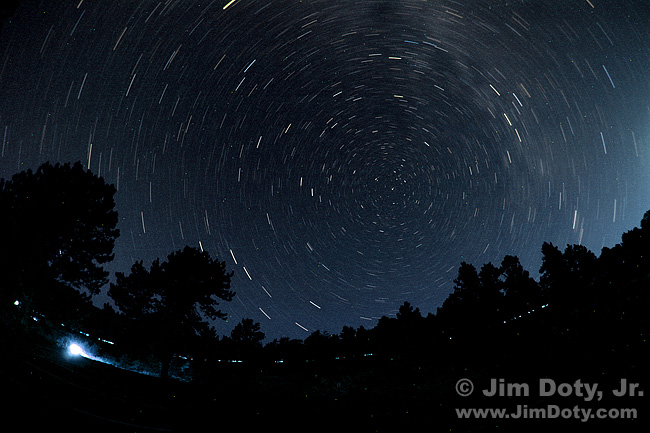Interested in getting into astrophotography? Here’s my advice.
The simple stuff is simple to do (like the photo above). The hard stuff is hard and complicated to do if you want eye popping photos like you see in Astronomy and Sky and Telescope magazines.
I suggest you start simple and work your way up to the more complex.
You can do simple stuff with just your camera, a lens, a locking cable release, and a decent tripod.
You can make a home made, mechanical “star tracker” for less than $10 that will track the motion of the stars for up to 15 minutes when using normal to wide angle lenses on your camera. Due to the inaccuracies of a home made rig, don’t use a lens longer than 50mm or an exposure longer than 15 minutes.
You can mount (piggy-back) your camera and lens on the back of a telescope, and let the telescope follow the rotation of the stars for much longer photos than 15 minutes. The telescope should do just fine tracking the stars so long as you don’t use a camera lens longer than 200mm. If course, the telescope needs to be a model with the ability to track the motion of the stars. This ability is usually built into the telescope mount.
If you want to shoot through the telescope (using the telescope as a super telephoto lens), you will need a telescope that can track the motion of the stars, an adapter to mount your camera to the telescope, an eyepiece, and a “guider”. Due to the long focal length of the telescope, even the best amateur tracking telescopes aren’t accurate enough to stay on track during the long exposures that are necessary (15- 30 minutes and typical), so you use a guider to pick and follow one star and to alter the motion of the telescope in order to stick with your guide star. Guiders come in the manul, do it yourself variety, and the automatic CCD variety. Special CCD astrophotography-cameras are also available for shooting through your telescope instead of using your normal camera body.
Do some reading before you start buying stuff. I highly recommend:
The Light-Hearted Astronomer by Ken Fulton. Reading this book first will save you a lot of heartache, not to mention dollars. Try and find this on the used market. Despite being technically dated, the advice is still very sound and the book is a fun read.
Nightwatch: A Practical Guide to Viewing the Universe by Terence Dickinson, Adolf Schaller, Victor Costanzo, and Roberta Cooke. Any recent version of Nightwatch will do. This is a great guide to viewing the night sky with naked eyes, binoculars, or a telescope. It is not a photography guide.
Splendors of the Universe, A Practical Guide to Photographing the Night Sky by Terence Dickinson and Jack Newton. Great book.
Astrophotography for the Amateur by Michael Covington, or Digital SLR Astrophotography, also by Covington. Another great book. I have the original version but not the newer digital version, so I can’t speak from personal experience regarding the newer version of this book but the reviews at Amazon are good.
In addition to the books listed above, I own several other books by Terence Dickinson. Just about anything he does is first class.
The book titles above are all linked to Amazon.
When you get ready to buy stuff, go here:
Fred Bieler really knows his stuff and his prices are very competitive. I have no financial connection with Astronomics – I’m just a very satisfied long-term customer.
The photo at the top of this post was taken with a tripod mounted Canon 5D camera and 15mm lens. A locking cable release was used to hold the shutter open. Exposure Data: f/4, 1253 seconds, ISO 100. That’s not a misprint, the shutter was open for 20 minutes, 53 seconds.

